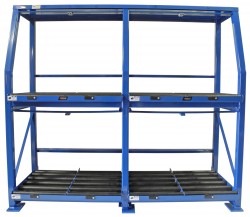We use cookies to make your experience better. To comply with the new e-Privacy directive, we need to ask for your consent to set the cookies. Learn more.
BHS Battery Room Floors and System Stands Increase DC Productivity, Avoid Downtime
The BHS Supplier Program provides total solutions for forklift battery rooms, including consultation, site analysis, equipment sales, and installation. BHS battery room specialists maintain close contact with companies after the battery room is complete, ensuring optimal battery room functionality during day-to-day operation.
Occasionally, clients ask their BHS Supplier Teams to address problems in battery charging areas built by competitors. This was the case in 2014, when a multinational Fortune 500 company asked BHS to investigate battery room conditions at one of their major North American distribution centers (DCs).
The Problem:
BHS Products Discussed in This Case Study
BHS Battery Room Floors
- Exceptional flatness and levelness
- 10,000 lb/in2 capacity
- Resistant to acid, abrasions, and impact
BHS System Stands
- Heavy duty steel construction
- Acid-resistant powder coat finish
- Spark-proof, poly-sleeved rollers
- Many customizable options
BHS Drip Pans
- Stainless steel materials
- Corner formed, eliminating seams
- Acid-resistant
- Easy to remove, easy to clean
AcidSorb Pillow
- Absorbs electrolyte drips
- Neutralizes sulfuric acid
- Indicates neutralization
- Fits into BHS Drip Pans
BHS Integrated Watering System
- Eliminates manual watering
- Replaces carts and hoses
- Ensures accurate watering
BHS Fleet Tracker
- Reduces battery change-out time
- Optimises battery usage
- Tracks maintenance tasks
- Allows sequenced watering
The forklift battery room at this Atlanta-based DC was engaged in a long, slow process of decline. BHS sent technicians to investigate, and the corrosion on battery and charger stands was already significant. Much of the room’s infrastructure had been prematurely aged by chronic electrolyte exposure, and the floors were scored and pitted where acidic battery runoff had accumulated over the years.
In addition to the obvious safety hazards caused by deteriorating battery storage equipment, the condition of the battery room caused facility-wide productivity losses. Forklift operators had to navigate around the most damaged sections of flooring, and battery handling staff was forced to work extra carefully to avoid placing too much stress on battery and charger stands.
The company did not keep exact figures about the time loss for each battery change, but we know that forklifts lose about 1.5 seconds per defect in the driving surface, thanks to analysis published in trade journal Material Handling & Logistics. Along with staff’s careful treatment of weakened stands and their avoidance of the corrosive slurry packed into the seams, the condition of the floor could easily double the time it took to change a battery.
Slower battery changes lead to queues at shift changes, limiting the production capabilities of entire forklift fleets. As workers waited in line for battery changes, material handling rates at the DC began to drop.
A meeting with the Corporate Team introduced a further complication into BHS’s response to the problematic equipment: the DC would have to continue operating at a high level of productivity while BHS worked to renovate the area and replace infrastructure. Whatever happened, the forklifts needed to stay on the floor.
BHS Analysis:
This battery room contained equipment that had been weakened over years of exposure to sulfuric acid, due to frequent leakage of electrolyte from charging forklift batteries.
Most forklift batteries lose some electrolyte during the charging process, and occasional spills can exacerbate the problem. If floors and stands are not treated to resist the sulfuric acid content of electrolyte, equipment is vulnerable to acidic corrosion. At the DC in question, years of exposure to electrolyte drips and spills had taken a toll on both the stands and the flooring.
The state of the battery room placed the client at risk of violating a number of federal standards from the Occupational Safety and Health Administration (OSHA) and the National Fire Protection Association (NFPA), including:
- CFR 1926.441(a)(3) - This OSHA standard requires battery storage facilities to be “substantial” and “resistant to the electrolyte.”
- CFR 1926.441(a)(4) - According to this OSHA standard, floors must be “of acid resistant construction unless protected from acid accumulations.”
- CFR 1910.22(b)(1) - In this general requirement for working surfaces, OSHA requires employers to keep “aisles and passageways. . .clear and in good repair.”
- NFPA 505, Standard 9.3.2.1(3) - This section of the Fire Safety Standards for Powered Industrial Trucks mandates protection for forklift battery chargers. Damaged charger stands could violate this regulation.
The DC’s battery stands came from a BHS competitor, and had not been treated with an acid-resistant coating — or, if they had, the coating had given way long ago, leaving stands vulnerable to the corrosive effects of battery leakage.
This equipment would need to be replaced by BHS System Stands (BS). Rugged steel construction, an acid-resistant powder finish, and poly-sleeved rollers prevent corrosion and acidic build-up on BHS System Stands, ensuring that the solution would be permanent.
The competitor’s battery stands also lacked any sort of drip control. BHS strongly recommends installing stainless steel drip pans to catch electrolyte runoff from batteries. For an additional layer of protection, BHS offers AcidSorb Pillows, which fit neatly into Drip Pans to absorb and neutralize acidic battery runoff, changing color to indicate full neutralization. Drip Pans would be an important element in the prevention of further equipment damage at the Atlanta DC.
The Solution:

BHS battery room specialists observed hazards to both safety and productivity in the DC’s battery storage area, all related to the damage to equipment and flooring. They developed a plan that would not only improve the situation in the short-term, but prevent similar conditions from developing in the future:
- Replace damaged battery racks and charger shelves with acid-resistant steel BHS System Stands. BHS System Stands are built to provide dependable, long-term service in the harsh environment of a battery room. They resist electrolyte spills, scratches, and impacts, ensuring that the client’s battery room will never reach the state of deterioration the BHS team found it in.
- Install Drip Pans beneath battery stands to protect floors. BHS floors are finished with a dual-layer of acid- and impact-resistant epoxy, but it is still safer to make sure that electrolyte never pools on the floor. Stainless steel Drip Pans with AcidSorb Pillow liners collect drips, preventing puddles of corrosive materials from forming beneath battery stands.
- Install a new, acid-resistant floor with two topcoats of impact-proof epoxy. Once the floor was brought into strict standards of flatness and levelness through a separate profiling and grinding process, the team installed an epoxy primer, followed by a mortar base. After another round of profiling and grinding to bring the floor within F-min specifications, they applied the dual-topcoat of acid-resistant epoxy.
- Recommended use of an Integrated Watering System and/or Battery Fleet Management Software. One of the most common causes of electrolyte runoff is over-watering, or watering before the charging cycle instead of after charging is complete. When these errors become ingrained in the institutional culture, battery cases, battery changers, storage systems, and floors can be exposed to chronic corrosive build-up.The BHS Integrated Watering System prevents both of these hazards by automating watering tasks. Fleet Management Software, such as the BHS Fleet TrackerTM, keeps maintenance schedules straight, and alerts battery room staff when it is time for upkeep.
Implementation:
The Atlanta DC case was handled in a series of steps, starting with the BHS Business Development Team. BHS specialists held in-depth conversations with the client and conducted the on-site survey of the DC’s battery room.
After taking measurements and discussing the options with the clients, the Team developed a customized plan to address the client’s concerns. At this point in the transaction, they handed control over to the BHS Engineered Systems Team to address the specific technical and engineering challenges of the project.
In order to meet the client’s goal of maintaining productivity throughout the renovation, BHS project managers methodically coordinated work schedules with the DC’s administration. The plan was to split the battery room in half and complete the installations in two phases. While one half of the floor was being ground down, coated in epoxy, and fitted with durable new battery stands, the other half would accommodate all battery changes with a fully functional — if somewhat crowded — temporary setup.
Once the first half of the battery room was complete, production moved across the line, and BHS’ Engineered Systems Team quickly completed the new floor and installed acid-resistant steel battery and charger stands.
Results:
All BHS equipment is tested and retested at the company’s St. Louis production facility — and when it was installed in the Atlanta DC, the team tested it again.
Once measurements proved that the new floor met the target F-min specifications, and that the stands were correctly installed for a lifetime of dependable use, the BHS team met with both facility managers and corporate leadership for follow-up interviews.
The clients were “exceedingly pleased with the rapid project management and customer service,” said Bill Wood, Director of Sales & Marketing North America. “The feedback was that of an absolute success.”
References:
“Batteries and Battery Charging - 1926.441.” Occupational Safety & Health Administration. United States Department of Labor, n.d. Web. 13 Aug. 2015.
Bond, Josh. “Lift Truck Tips: Battery Room as Fleet Barometer.” Modern Materials Handling. Peerless Media, LLC, 1 Jan. 2012. Web. 16 Sept. 2015.
“NFPA 505: Fire Safety Standard for Powered Industrial Trucks, Including Type Designations, Areas of Use, Conversions, Maintenance, and Operations.” NFPA. National Fire Protection Association, 2013. Web. 16 Sept. 2015.
“Powered Industrial Trucks - 1910.178.” Occupational Safety & Health Administration. United States Department of Labor, 2006. Web. 16 Sept. 2015.
Shoemaker, Ken. “How a Floor Can $ave Millions.” Mhlnews. Penton, 1 Nov. 2007. Web. 16 Sept. 2015.

